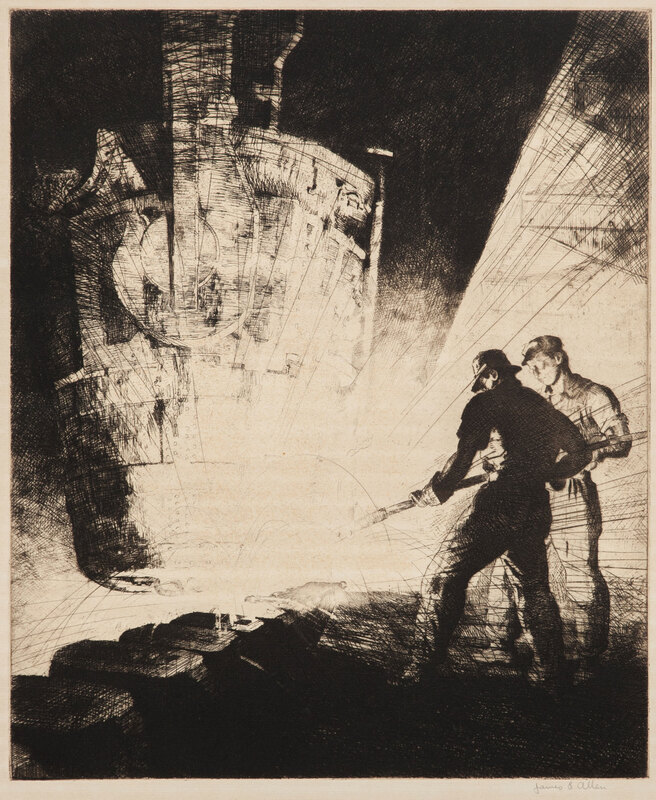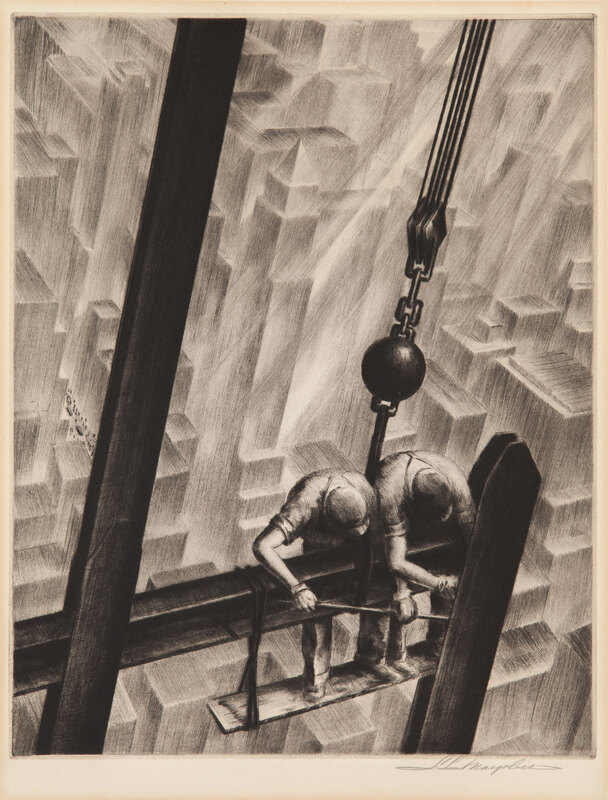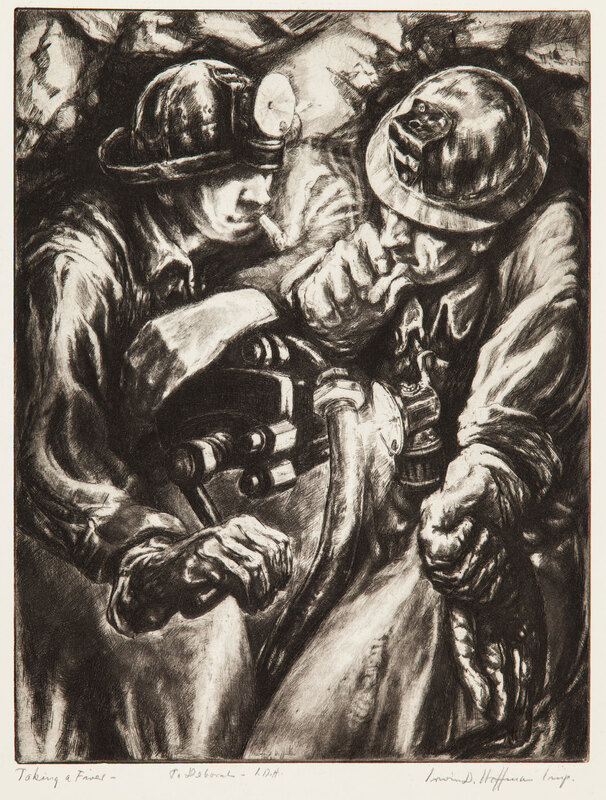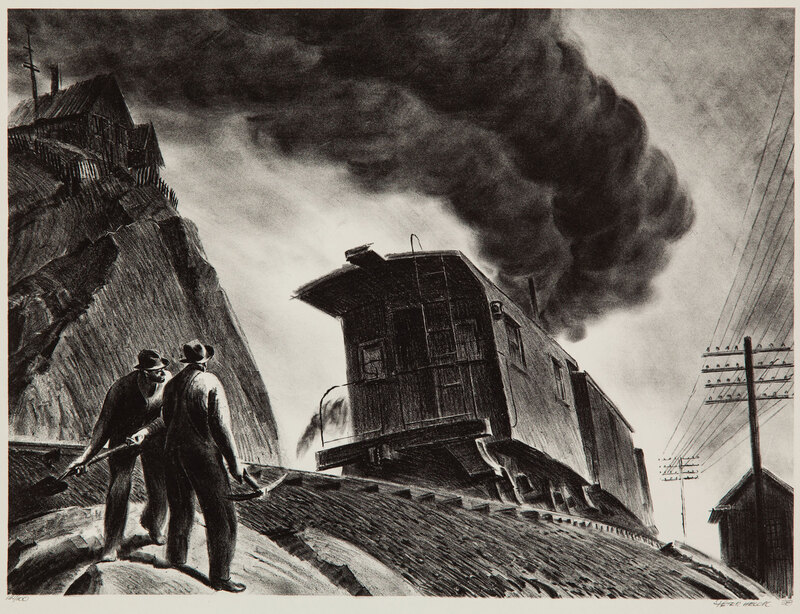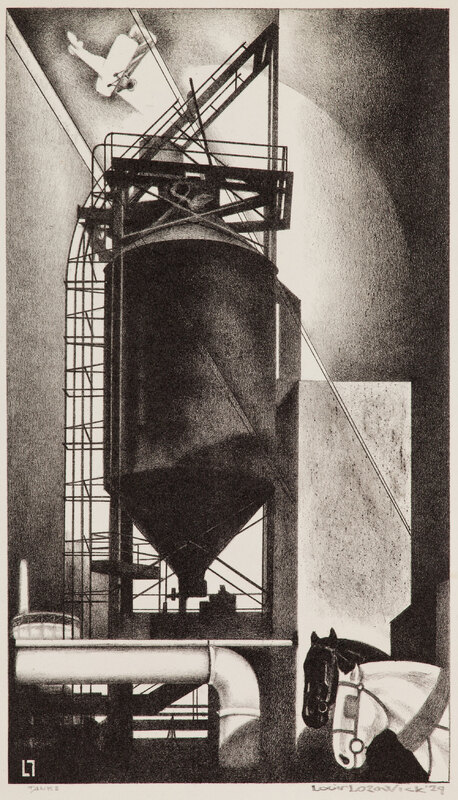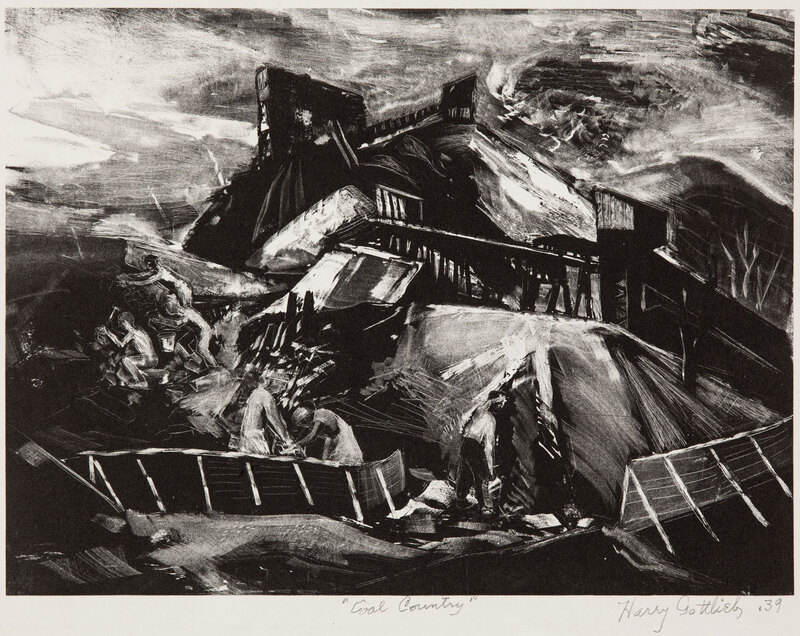Labor
The once-thriving American industrial sector was hit hard by the Depression. Artists responded by depicting laborers, especially steel workers, as productive and strong – even heroic.
Prior to the 1930s, the United States had experienced almost uninhibited industrial growth and had outpaced Europe in 1900 as the world’s foremost exporter of industrial goods. The global economy, however, ground to a halt following Black Tuesday and one of the hardest hit sectors was industrial production. In the most heavily affected areas, production was more than halved. Iron and steel production, an industry that had driven the expansion of cities like New York and Chicago, fell by almost 65% in a matter of three years. As a result, the urban work force suffered enormously, with steel cities like Akron, Ohio reporting a staggering 60% unemployment rate
These statistics, however, fail to communicate an important element of the Great Depression—it took much more than an economic toll. Industrial workers, especially in the steel and auto industries, were an important source of national pride, representing the progress of modernization. Their unemployment was easily seen as a symbol of the country’s dire position.
For this reason, New Deal artists often chose the industrial laborer—especially the steel worker—as their subject. Rather than show them disempowered and unemployed, however, artists often portrayed heroic workers engaged in the rebuilding of the nation. Although many unemployed Americans suffered from malnutrition, especially in the early years of the Depression, artists frequently showcased brawny, powerful laborers.
Not all portrayals of labor were heroic, however. Some artists emphasized the dangerous working conditions under which many Americans continued to labor. Coal miners often appear tragically in 1930s art as a way to emphasize laborers’ powerlessness against capitalist demands. In contrast, artists portrayed the danger that steelworkers faced not to emphasize their victimhood, but instead to underscore their power and bravery. The average steel worker, notably, didn’t experience their labor in such heroic terms. One worker told an interviewer for the Federal Writers’ Project in 1938 that “you ain’t an iron worker unless you get killed.” These kinds of conditions drove protest and unionization in the 1930s.
––CCG
James E. Allen (American, 1894 – 1964)
Teeming Ingots, 1935
etching; 14 ¾ x 12 ¼”
Binghamton University Art Museum, 2016.4.70
gift of Gil and Deborah Williams
James E. Allen was raised in Montana, but traveled to Chicago and then New York City to study art until the dawn of World War I, when he volunteered as a fighter pilot. Teeming Ingots was one of the most popular prints he created and earned praise from the Society of American Etchers upon its publication in 1935.
Allen’s realist style frequently celebrated the heroism of industrial laborers. In this etching, two steel workers pour molten metal into forms to make ingots or blocks. The process brightly illuminates their bodies, revealing not only strong physiques, but also their uniforms—overalls over a cuffed shirt. Note, too, that the only protection they wear are goggles and heat-resistant gloves! The two men appear in charge despite the dangerous situation, something that suggests their skill and fortitude.
––CCG
Samuel L. Margolies (American, 1897 – 1974)
Men of Steel, 1936
drypoint; 16 ½ x 13”
Binghamton University Art Museum, 2016.4.326
gift of Gil and Deborah Williams
Samuel L. Margolies was born in 1897 in New York City to Jewish parents. As a young man, he studied art in the city and would later join the Federal Art Project in the 1930s to sustain himself.
This drypoint shows two men linking steel beams high above the skyline of Margolies’s native New York. They are bowed in concentration, their feet resting on a narrow plank of lumber. In 1939, this print was exhibited at the New York World’s Fair and later was sold in the Associated American Artists’ “Art for Every Home” catalogue.
You might notice the name of the piece—Men of Steel—sounds a lot like Superman’s nickname. The invention of this superhero actually dates to this period. The phrase “man of steel” emphasizes strength, both mental and physical. Think of the courage it would take to work so high above the city!
––CCG
Herschel Levit (American, 1912 – 1986)
Take It Away!, 1945
lithograph; 19 x 12 ½”
Binghamton University Art Museum, 2016.4.30
gift of Gil and Deborah Williams
Herschel Levit studied art in Philadelphia and Chicago and, during the Great Depression, worked for the Federal Art Project.
In this lithograph, a solidly-built construction worker gestures to an unseen colleague in an overhead crane to lift a load of construction materials. He is smiling, clearly enjoying his work. Depictions of American workers during the Second World War mirrored that of the Depression era—heroic, strong, powerful. Even though he is not engaged in a war industry, this worker is doing his part with patriotic zeal.
––CCG
Irwin D. Hoffman (American, 1901 – 1989)
Taking a Fiver, 1940
etching and aquatint; 20 x 13”
Binghamton University Art Museum, 2016.4.157
gift of Gil and Deborah Williams
Interpretive text has not been prepared for this object.
Clarence Peter Helck (American, 1893 – 1988)
Fast Freight, 1938
lithograph; 16 ¼ x 23 ¾”
Binghamton University Art Museum, 2016.4.117
gift of Gil and Deborah Williams
Interpretive text has not been prepared for this object.
Louis Lozowick (American, born Ukraine, 1892 – 1973)
Tanks (No. 1), 1929
lithograph; 19 ½ x 14 ¼”
Binghamton University Art Museum, 2017.6.1
gift of Gil and Deborah Williams
Interpretive text has not been prepared for this object.
Jolan Gross Bettelheim (American, born Hungary, 1900 – 1972)
Employment Office, 1935-36
lithograph; 16 ½ x 11 ½”
Binghamton University Art Museum, 2016.4.174
gift of Gil and Deborah Williams
Interpretive text has not been prepared for this object.
Harry Gottlieb (American, born Romania, 1895 – 1992)
Abandoned Coal Mine, ca. 1935-36
lithograph; 15 ¾ x 22 ¾”
Binghamton University Art Museum, 2016.4.244
gift of Gil and Deborah Williams
Harry Gottlieb was born to a Jewish family in Romania. They immigrated to Minneapolis in 1907, when Gottlieb was twelve. After studying at the Minneapolis Institute of Art, Gottlieb moved to New York and adopted a social realist style. He became one of tens of thousands of Americans who joined the Communist Party during the Great Depression and used his art to celebrate the working class. He produced this lithograph while employed in the Federal Art Project.
Since the Industrial Revolution, coal had been an enduring symbol of American industry, necessary not only to power factories and homes, but also to produce steel, which combined coal and iron ore. In many artists’ imaginations, however, coal workers were tragic figures due to the harsh conditions and high mortality rates they faced. In this way, they were often the negative referent to the independent, heroic steel worker. In this piece, men disappear into the landscape as they scavenge around an abandoned mine for coal to sell or heat their homes.
––CCG
